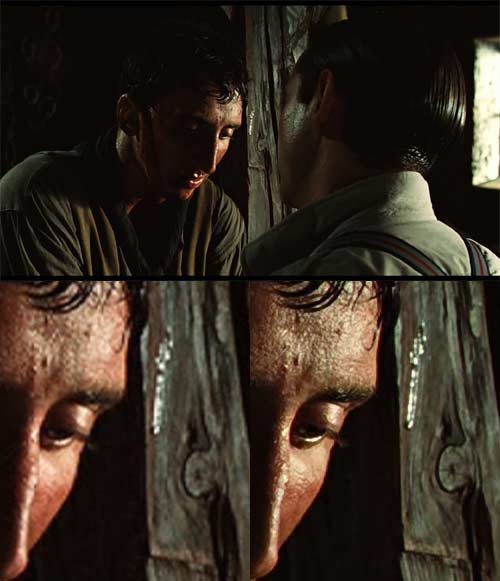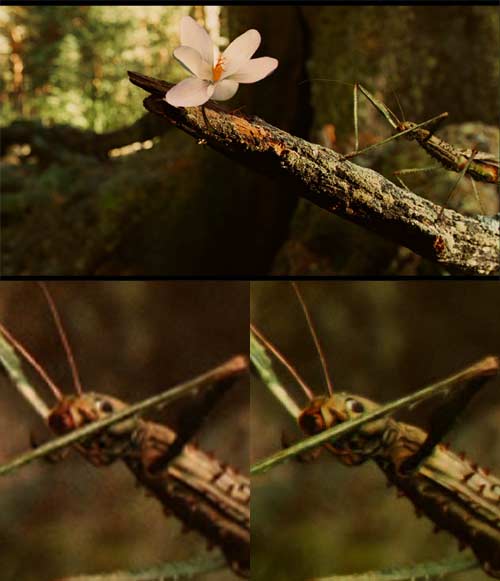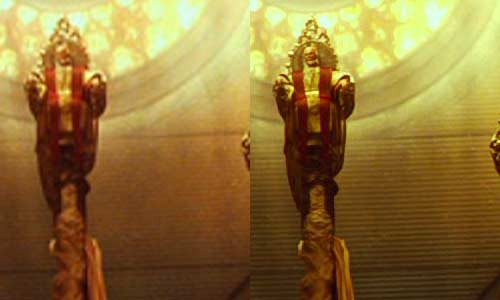 Picture:
Picture:  Sound:
Sound:  Extras:
Extras: 
 Pan's Labyrinth
Pan's Labyrinth
Movie:  Picture:
Picture:  Sound:
Sound:  Extras:
Extras: 
The movie itself? It's a dark, dark fairy tale embedded in a dark, dark naturalistic drama. It is brilliant, unlike anything you've any seen, and definitely not suitable for the little ones (the Australian DVD is rated MA).
I purchased this from Amazon with a couple of others I figured would not be appearing from Australian distributors in the short term. This disc is definitely region free, so you won't have any problems there.
The main audio track (in Spanish) is presented -- for the first time in my high definition collection, aside from test discs -- in 7.1 channels. The codec used is DTS-HD Master Audio. The sound is truly wonderful, as you'd expect from such a recent movie.
The commentary is presented, unusually, in stereo DTS sound. According to the home theatre receiver I was using, this had a bitrate of 'Open', which I presume to mean variable bit rate, which is something I haven't seen before. The same audio was used a quite a number of the special extras. Whatever it was, the receiver took a second or so to lock onto the sound each time I switched to some content using it, suggesting that it is of a format not commonly used.
For special extras you get nearly four hours of video in the form of featurettes, a TV show on the recent wave of brilliant Mexican movie directors, trailers, comparisons and even some comics. And you get 414 high definition still images, from conceptual sketches through to production photographs and publicity photos.
Plus you get the whole thing to watch again with 'Enhanced Video Commentary'. This has the standard director's commentary (available without the accompanying pictures) shown with various still and video extras in a window. But it is not a BonusView disc. As far as I can work out, the entire movie is repeated for this presentation, but it is possible that some space was saved by the use of seamless branching. After all, the picture quality of the movie is so exemplary, there were clearly no space limitations.
Another difficult one is what resolution was used for the sound. The DTS-HD Master Audio provided on this disc can support just about anything, including even 192kHz sampling and 24 bits of resolution. Lossless compression systems for audio typically achieve a compression ratio of about 2:1. 5.1 channels of sound at 16 bits and 48,000 hertz sampling require 4,608kbps. If the sound is encoded in DTS-HD Master Audio or Dolby TrueHD and a bitrate meter indicates 2.5Mbps, then it's a fair assumption that the resolution of the sound is 48kHz, 16 bits. For this disc, the sound is generally up around 4.4 to 4.5Mbps, and the scene in which our heroine faces the giant frog under thre tree sits around 5.5Mbps, peaking up at 6.7Mbps! That scene is rather more surround intensive than much of the movie. So I am assuming it is 24 bit, 48kHz sound (uncompressed, in 7.1 channels 9,216kbps would be required). That's what I've put below.
Finally, in the review above I talked about seamless branching for the 'Enhanced Video Commentary'. I'm not so sure about that now. The PS3 reports that the video bitrate is typically between 8Mpbs and 15Mbps. AnyDVD reports that the disc is nearly 44GB in size. My suspicion is that the movie was recorded twice in its entirety, the second time with what looks like PIP elements, but which are actually hard coded into the video.
The right side is from the New Line Home Entertainment Blu-ray, which I purchased from Amazon in the US. This has not been scaled at all. Different applications were used to capture the two frames, so I am not comfortable comparing the colour between the two, merely the detail and sharpness. For those visitors from NTSC lands, generally the PAL DVD is just a touch sharper than the NTSC DVD.
Normally in these layouts I zoom in on points of interest to the story, but inthis frame let us look elsewhere. The detail is from the left upper quadrant. You can see the hill rising. It adds little if anything to the story. Still, see how much more restful on the eye this is. Imagine a large screen in front of you filled up with the fuzziness of the left, compared to the clarity of the right:

Okay, so here we have yet another comparison. Clearly the Blu-ray is better. The man has been tortured, and we see this better in his sweat-encrusted forehead, the hairs stuck to it, the pores naked.

Now here is the same comparison, but with one difference. I used Photoshop (with the 'Bicubic' resampling method and with 'Constrain Proportions' deselected) to scale the 1,920 by 1,080 Blu-ray shot down to 720 by 576 pixels (the same size as a PAL DVD frame), and then back up to 1,920 by 1,080 pixels again. The rest is the right of the graphic below. I think there is a very slight amount more detail in the resized Blu-ray shot than the plain DVD shot (see the hint of pores on his cheek, for example), but there really isn't much in it. It is pretty much all in the resolution.

Really, not much needs to be said about this. Nor, indeed, any of the others (unless I change my mind once I load them). They are here presented for your inspection:



So I have changed my mind after all, for this is interesting. See the vertical spikes upwards on the hard diagonal edge of the dress? Pretty obvious on the DVD one. Just about invisible on the Blu-ray one, but it's actually there as well, just a lot smaller. The reason these defects are more noticable is because of the way colour is encoded in these formats. Both use a YCRCB format. The luminance (black and white) has its own signal, and colour difference signals handle the rest. But the colour difference signals are only coded with one quarter of the resolution of the luminance signal. With the purity of red in this dress and the hard contrast against near white and near black, along with me scaling the picture up to Blu-ray resolution, this reduction of detail becomes pretty obvious.

I couldn't resist demonstrating a bit more of the differences in information revealed by these two disc formats:
